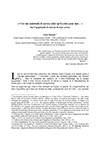Louis Dautais
« “C’est une multitude de navires-kftjw qu’il a faits pour moi...”. Sur l’égyptianitĂ© du bateau de type crĂ©tois »
ENiM 14, 2021, p. 75-89.
 « C’est une multitude de navires-kftjw qu’il a faits pour moi… ». Sur l’égyptianité du bateau de type crétois. Au sein du vocabulaire égyptien relatif au monde égéen, le bateau kftjw (i.e. « de type crétois » = BTC) est mentionné à trois reprises dans la documentation, sous les règnes de Thoutmosis III et celui de son fils et successeur, Amenhotep II. Néanmoins, leur signification est aujourd’hui toujours l’objet de débats. D’après les travaux antérieurs des égyptologues et égéanistes, elle pourrait désigner soit la destination du voyage, soit l’origine de la construction et/ou un port d’attache. La relecture de la documentation textuelle permet de démontrer que ces navires sont construits à l’égyptienne, en Égypte, par et pour des Égyptiens.
« C’est une multitude de navires-kftjw qu’il a faits pour moi… ». Sur l’égyptianité du bateau de type crétois. Au sein du vocabulaire égyptien relatif au monde égéen, le bateau kftjw (i.e. « de type crétois » = BTC) est mentionné à trois reprises dans la documentation, sous les règnes de Thoutmosis III et celui de son fils et successeur, Amenhotep II. Néanmoins, leur signification est aujourd’hui toujours l’objet de débats. D’après les travaux antérieurs des égyptologues et égéanistes, elle pourrait désigner soit la destination du voyage, soit l’origine de la construction et/ou un port d’attache. La relecture de la documentation textuelle permet de démontrer que ces navires sont construits à l’égyptienne, en Égypte, par et pour des Égyptiens.
 “It’s a multitude of Kftjw-ships that he made for me…”. On the Egyptianity of the Cretan type boat. Within the Egyptian vocabulary related to the Aegean world, the kftjw boat (i.e. “Cretan type” = CTB) is mentioned three times in the documentation during the reigns of Thutmose III and that of his son and successor, Amenhotep II. Nevertheless, its meaning remains controversial. Earlier Egyptologists and Aegeanists scholars interpreted the term either as an indication of the ship’s destination, the origin of its construction or its home port. A reassessment of the textual documentation, however, demonstrates that these ships were built in Egypt, in the Egyptian way, by and for Egyptians.
“It’s a multitude of Kftjw-ships that he made for me…”. On the Egyptianity of the Cretan type boat. Within the Egyptian vocabulary related to the Aegean world, the kftjw boat (i.e. “Cretan type” = CTB) is mentioned three times in the documentation during the reigns of Thutmose III and that of his son and successor, Amenhotep II. Nevertheless, its meaning remains controversial. Earlier Egyptologists and Aegeanists scholars interpreted the term either as an indication of the ship’s destination, the origin of its construction or its home port. A reassessment of the textual documentation, however, demonstrates that these ships were built in Egypt, in the Egyptian way, by and for Egyptians.
 Consulter cet article (47450) -
Consulter cet article (47450) -  Télécharger cet article au format pdf (21537)
Télécharger cet article au format pdf (21537)
ENiM 18 - 2025
8 article(s) - 8 octobre 2025.
ENiM 1 à 18 (2008-2025) : 227 articles
5 170 971 téléchargements
10 334 238 consulations.
Index des auteurs

Mots clés

Derniers articles : 
CENiM - Mise en ligne des volumes Ă©puisĂ©s : 
 Anne-Sophie von BOMHARD DĂ©cans Ă©gyptiens, CENiM 23, Montpellier, 2020 — (2020)
Anne-Sophie von BOMHARD DĂ©cans Ă©gyptiens, CENiM 23, Montpellier, 2020 — (2020) 
 Jean-Claude Grenier L'Osiris ANTINOOS, CENiM 1, Montpellier, 2008 — (26 dĂ©cembre 2008)
Jean-Claude Grenier L'Osiris ANTINOOS, CENiM 1, Montpellier, 2008 — (26 dĂ©cembre 2008) 
TDENiM - Mise en ligne des volumes Ă©puisĂ©s : 
 Twitter
Twitter 4136236 visites - 6962 visite(s) aujourd’hui - 120 connecté(s)
© ENiM - Une revue d’égyptologie sur internet
Équipe Égypte Nilotique et Méditerranéenne - UMR 5140 - « Archéologie des Sociétés Méditerranéennes » (Cnrs) - Université Paul Valéry - Montpellier III






















 Contact
Contact
 Abonnez-vous !
Abonnez-vous ! Équipe Égypte Nilotique et Méditerranéenne
Équipe Égypte Nilotique et Méditerranéenne UMR 5140 « Archéologie des Sociétés Méditerranéennes » (Cnrs)
UMR 5140 « Archéologie des Sociétés Méditerranéennes » (Cnrs) Université Paul Valéry - Montpellier III
Université Paul Valéry - Montpellier III